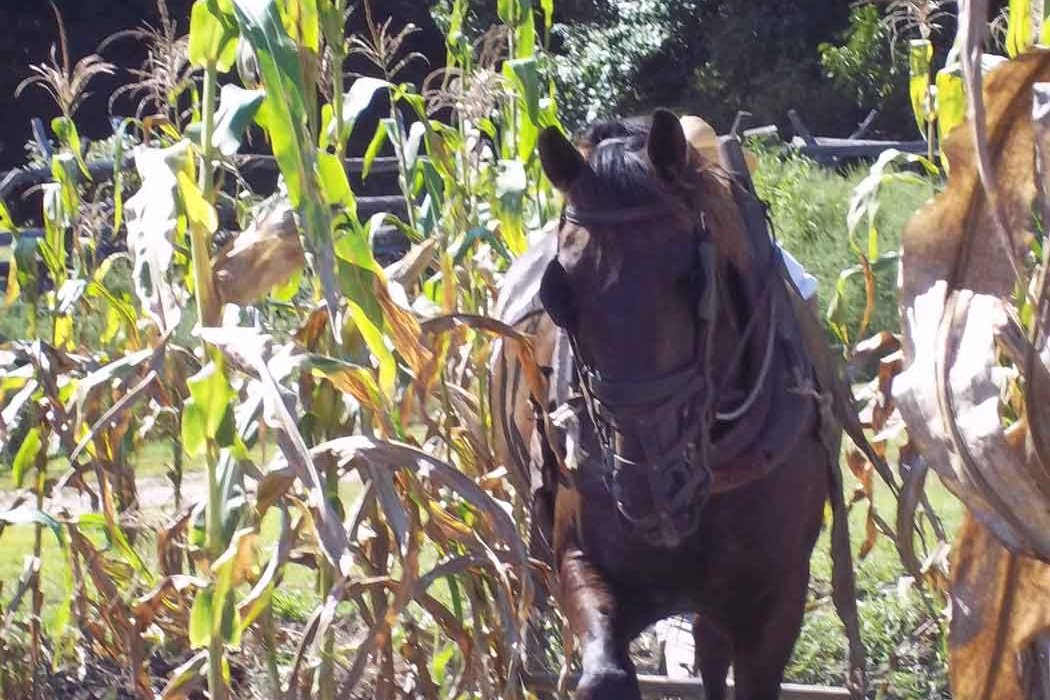
How to Kill Weeds like an Eighteenth-Century Farmer
Colonial techniques you can try today
Thoughts of a Farmer Part III: Tillage Techniques by Horse and by Hand
Imagine the sight of this horse coming towards you as you stand on the edge of the field. Behind the horse comes a human using a plow to work the earth up. You can smell the sweat of the horse and more often than not — that of the Historic Farmer.
This horse-drawn plow is the ultimate in weed-killing techniques, but there is another way that is almost as old as humankind — the hoe. With these tools, 18th-century Tidewater Virginia farmers, both free and enslaved, killed weeds to improve prospects for a good crop.
The old saying goes that you should not plant what you cannot tend. I have seen it so many times … and have been guilty of it many times as well. Without weed killing, no crop or garden can produce. A verdant growth of weeds is unsightly, but it is really about what is happening underneath the soil, as the plant is being robbed of essential nutrients and water.
Peter Kalm, a Swede traveling throughout North America, wrote on December 14, 1750, “Maize (corn) is a food plant, which, more than all others, needs to be kept free from weeds.” To make a good corn crop was imperative. Left to dry on the stalk and ground up for cornmeal, it was the mainstay of common people’s diet. In turn, tobacco was the cash crop that provided revenue to Virginia farmers. Weeds robbed the soil of the nutrients needed to produce big leaves. Smaller tobacco leaves meant less money. Kill the weeds and make food with corn and money with tobacco. It is as simple as that!
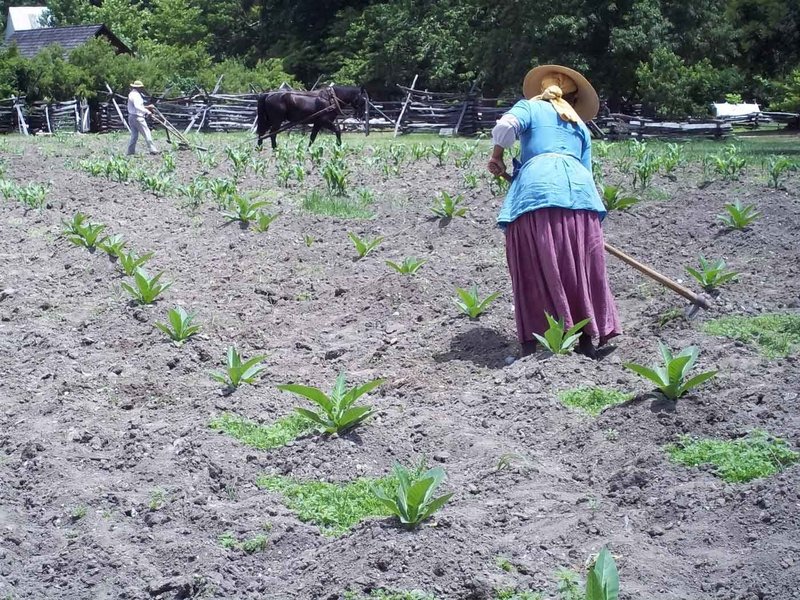
Katrina Lewis hoes out weeds amongst tobacco as Ed Schultz cultivates in the corn with a horse.
The implement that the Historic Farming Trade uses with a horse is the hoe plow. It has a point shaped like a triangle and cuts about four inches below the surface. After many miles of use over the last 18 years, I have found it to be the “Cadillac” of cultivators. Notice how easy it looks in the photo above. Just strolling along as the horse pulls it between the plants.
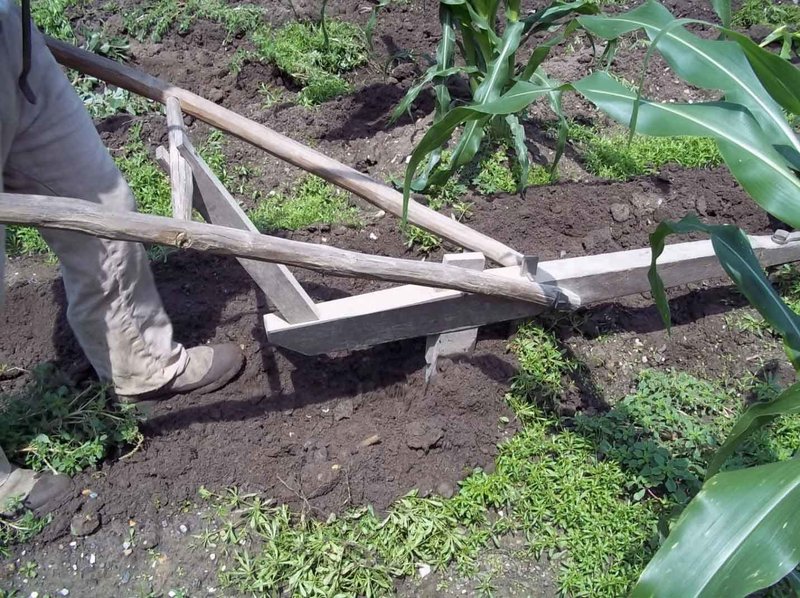
The action of the hoe plow working just below the surface.
The hoe plow gets most, but not all the weeds in between the plants. The rest are touched up by hand with a hoe. But for many farmers who could not afford a horse, all the weeds were killed by a hoe. This approach would reduce corn production by over half, so the advantage of using a horse and plow is indeed significant.
A hoe called the broad hoe was used for weeding. The width of the blade allowed more weeds to be killed with each stroke. A simple technique was used to get out the deep roots of some weeds by using the corner to flake them out.
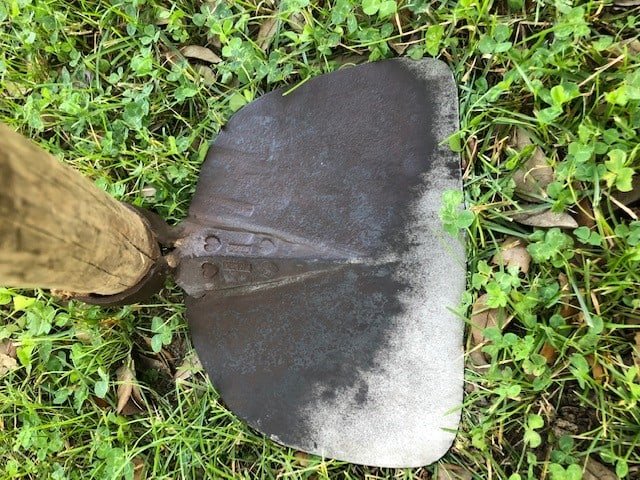
The width of a broad hoe gets more work done with every stroke. Notice the shiny corner where it is used to get deeper weeds out.
Believe it or not, there is an art to all this weed killing. Technique of hand and the right approach in the head is critical if one has a long row to hoe. When I first started in historical farming 30 years ago at the Homeplace 1850 in Kentucky, a co-worker named Travis Wheeler saw me flailing away with the hoe —bent over and full of fury at the weeds. Out of the corner of my eye I could see him shaking his head. As I looked up, he said: “You better start standing up when you hoe or you’re not going to be able to stand up one day.” He spoke from experience as he was the son of a tobacco farmer who still hoed out some of their fields. I altered my technique by standing erect when I use the hoe. You can see this technique more clearly by watching the below video on hoeing.
Another essential element is weeding at the right time. Do not let the weeds go to seed! Once this happens, you will shatter millions of seeds on every swing of the hoe which nicely re-plants them, requiring more hoeing next week or next year and the next and next. It is usually hot when you are weeding. I have found this to be a good thing, though, as a weed chopped out and lying in the sun will fry up and die quickly, giving it less chance of re-rooting itself. To this farmer, a dead weed shriveled up and killed by the sun is somehow gladdening to the heart.
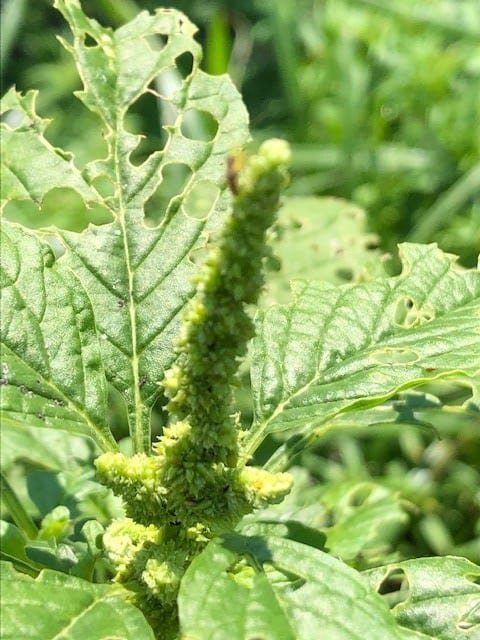
The end of the world. Pigweed gone to seed!
How, though, does a farmer get their head around looking at a long row of weeds that must be killed under the hot burning rays of the sun? Over time, I have learned two methods. Wear a hat to cool your head and think only about killing the weeds. This focuses your attention on the work at hand, not what other tasks you might have to do. And when you waver, try this—look back on what you have done more than what you need to do. These methods have worked for me in the fields at Colonial Williamsburg. Perhaps they will work for you as well.
A field (or a garden) full of weeds is an unsightly mess that will result in a bad crop. Landon Carter, a Tidewater Virginia planter, wrote in his diary on June 16th, 1773 “…so I am in hopes we shall get all out the first weeds by the 26th which used to be a sign of a good Planter.” The present is sometimes like the past. My friend Donny Craig would pass judgment on farmers with weedy fields in the rich vernacular of Upcountry South Carolina, “that grass done took that corn!” If weeds are allowed to take the crop, they can take the farmer's reputation with it.
Peter Kalm and Landon Carter from the 18th century knew that weeds are the enemy of a good crop just like Travis Wheeler and Donny Craig know today. Some things do not change over time. Sometimes, others say echoes of the past right into our ears.
Be a good farmer. Be a Weedkiller!
Sources
Carter, Landon. The Diary of Landon Carter of Sabine Hall, 1752-1778. Edited by Jack Greene. Charlottesville: University Press of Virginia, 1965.
Gray, Lewis Cecil. 1958. History of Agriculture in the Southern United States to 1860, Volume II. Gloucester, Massachusetts: Peter Smith.
Kalm, Peter. Travels into North America: Containing Its Natural History, and a Circumstantial Account of Its Plantations and Agriculture in General; with the Civil, Ecclesiastical and Commercial State of the Country, the Manners of the Inhabitants, and Several Curious and Important Remarks on Various Subjects. London: Printed for T. Lowndes, 1772.
